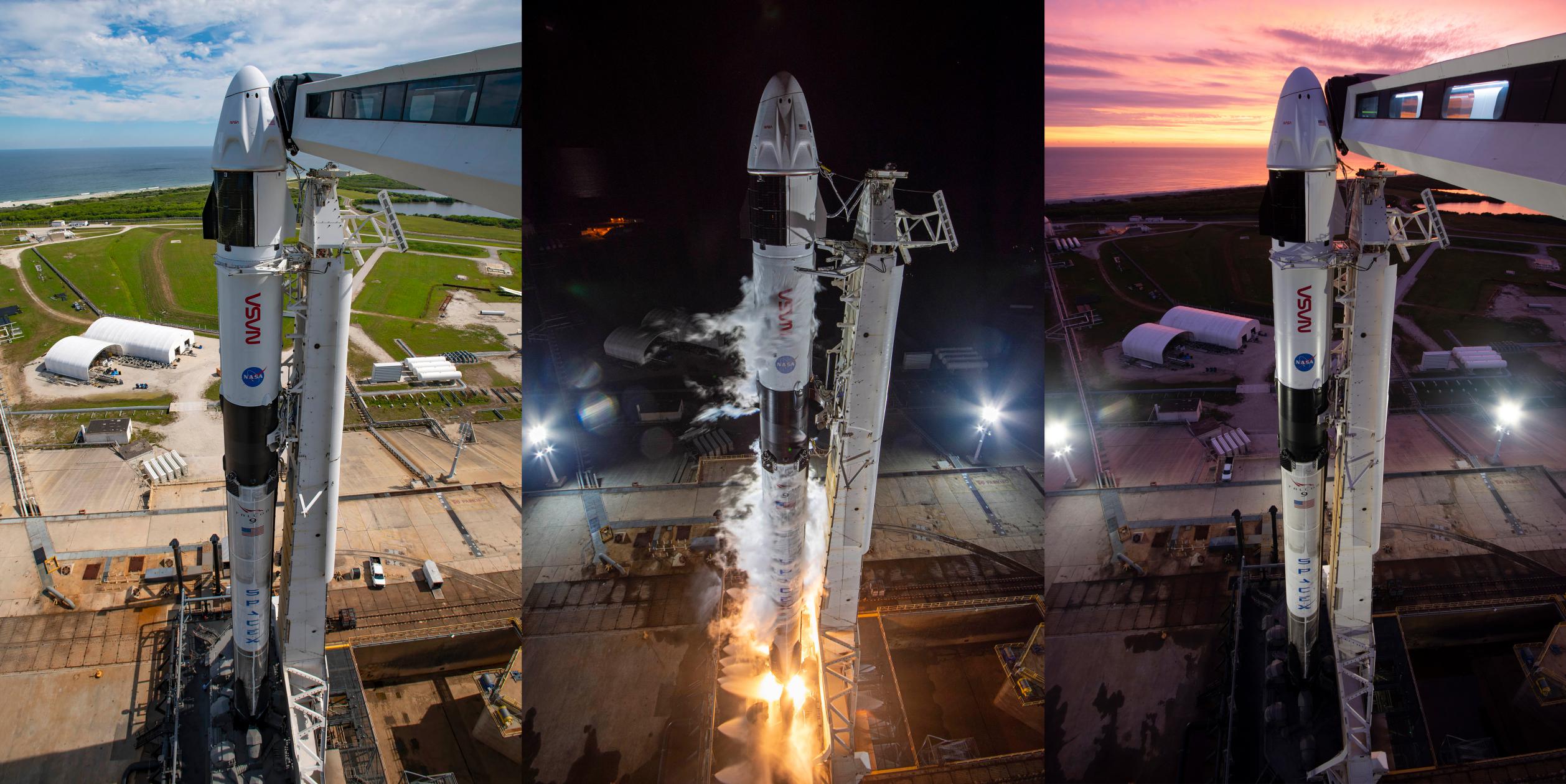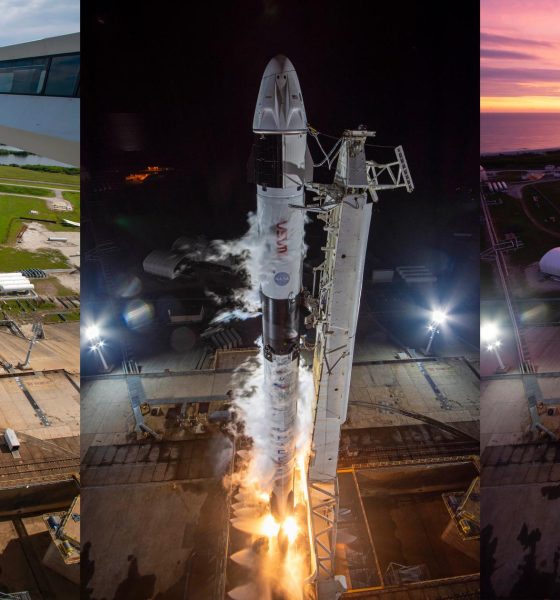

News
Watch Live: SpaceX, NASA are ‘go’ for third operational astronaut launch
With less than three hours to go before liftoff, SpaceX and NASA remain on track – with the vehicle, crew, and weather conditions all in great shape – for Falcon 9 and Crew Dragon’s third operational astronaut launch.
Originally scheduled for late October, a minor crew health issue, a small hardware qualification delay, and – primarily – a variety of good and bad weather conditions ultimately pushed Crew-3 into the second week of November. As a result, SpaceX and NASA chose to return Dragon and four Crew-2 astronauts to Earth before launching Crew-3, and that process was flawlessly completed on the evening of November 8th. During Dragon’s fourth crewed reentry descent and landing, though, one of the spacecraft’s four main parachutes ran into a minor but well-understood issue.
Designed to safely splash down with one parachute out, the safety of the Crew-2 astronauts was never in question but the apparent parachute issue was easily visible to anyone watching NASA and SpaceX’s live coverage. In reality, the behavior observed had been seen – and even intentionally created – many times before in the dozens upon dozens of Dragon parachute tests SpaceX completed to qualify the system for human spaceflight. Specifically, one or more of Dragon’s four huge chutes occasionally lags behind and takes longer to fully inflate. In the case of Crew-2, the problem chute behaved exactly as expected based on that testing and ultimately wasn’t a problem at all, properly inflating to slow Dragon to the exact desired descent speed well before splashdown.
Nevertheless, out of an abundance of caution, virtually everyone familiar with NASA and the Commercial Crew Program expected the agency to closely examine the behavior and make absolutely sure that all is well. Indeed, in a prelaunch briefing late last night, SpaceX VP Bill Gerstenmaier confirmed as much, revealing that the company rapidly completed reviews of Crew-2 and Crew-3 parachute build data and even airlifted the problem chute – recovered from the Atlantic – back to Florida facilities. Less than 24 hours after that parachute was in Earth orbit, SpaceX managed to dry it out and complete thorough inspections – all with NASA officials in the loop – to confirm that the chute itself was healthy (undamaged, no missed design/build errors, etc).


Ultimately, in an impressive display of professionalism and expertise, SpaceX and NASA were able to verify in a matter of hours that Crew-2’s reentry, descent, and landing was fully nominal and posed no problem for Crew-3’s launch just two days later. Crew-3 remains on track to lift off no earlier 9:03pm EST Wednesday, November 10th (02:03 UTC 11 Nov) with NASA astronauts Raja Chari, Thomas Marshburn, and Kayla Barron and ESA astronaut Matthias Maurer.
Falcon 9 booster B1067 will attempt to land on drone ship A Shortfall Of Gravitas around nine and a half minutes after liftoff following its second Dragon and first astronaut launch. Crew-3 will reach orbit shortly before and Dragon will begin a 22-hour journey to the ISS with plans to dock around 7pm EST Thursday, November 11th.

News
Nvidia CEO Jensen Huang explains difference between Tesla FSD and Alpamayo
“Tesla’s FSD stack is completely world-class,” the Nvidia CEO said.

NVIDIA CEO Jensen Huang has offered high praise for Tesla’s Full Self-Driving (FSD) system during a Q&A at CES 2026, calling it “world-class” and “state-of-the-art” in design, training, and performance.
More importantly, he also shared some insights about the key differences between FSD and Nvidia’s recently announced Alpamayo system.
Jensen Huang’s praise for Tesla FSD
Nvidia made headlines at CES following its announcement of Alpamayo, which uses artificial intelligence to accelerate the development of autonomous driving solutions. Due to its focus on AI, many started speculating that Alpamayo would be a direct rival to FSD. This was somewhat addressed by Elon Musk, who predicted that “they will find that it’s easy to get to 99% and then super hard to solve the long tail of the distribution.”
During his Q&A, Nvidia CEO Jensen Huang was asked about the difference between FSD and Alpamayo. His response was extensive:
“Tesla’s FSD stack is completely world-class. They’ve been working on it for quite some time. It’s world-class not only in the number of miles it’s accumulated, but in the way it’s designed, the way they do training, data collection, curation, synthetic data generation, and all of their simulation technologies.
“Of course, the latest generation is end-to-end Full Self-Driving—meaning it’s one large model trained end to end. And so… Elon’s AD system is, in every way, 100% state-of-the-art. I’m really quite impressed by the technology. I have it, and I drive it in our house, and it works incredibly well,” the Nvidia CEO said.
Nvidia’s platform approach vs Tesla’s integration
Huang also stated that Nvidia’s Alpamayo system was built around a fundamentally different philosophy from Tesla’s. Rather than developing self-driving cars itself, Nvidia supplies the full autonomous technology stack for other companies to use.
“Nvidia doesn’t build self-driving cars. We build the full stack so others can,” Huang said, explaining that Nvidia provides separate systems for training, simulation, and in-vehicle computing, all supported by shared software.
He added that customers can adopt as much or as little of the platform as they need, noting that Nvidia works across the industry, including with Tesla on training systems and companies like Waymo, XPeng, and Nuro on vehicle computing.
“So our system is really quite pervasive because we’re a technology platform provider. That’s the primary difference. There’s no question in our mind that, of the billion cars on the road today, in another 10 years’ time, hundreds of millions of them will have great autonomous capability. This is likely one of the largest, fastest-growing technology industries over the next decade.”
He also emphasized Nvidia’s open approach, saying the company open-sources its models and helps partners train their own systems. “We’re not a self-driving car company. We’re enabling the autonomous industry,” Huang said.
Elon Musk
Elon Musk confirms xAI’s purchase of five 380 MW natural gas turbines
The deal, which was confirmed by Musk on X, highlights xAI’s effort to aggressively scale its operations.

xAI, Elon Musk’s artificial intelligence startup, has purchased five additional 380 MW natural gas turbines from South Korea’s Doosan Enerbility to power its growing supercomputer clusters.
The deal, which was confirmed by Musk on X, highlights xAI’s effort to aggressively scale its operations.
xAI’s turbine deal details
News of xAI’s new turbines was shared on social media platform X, with user @SemiAnalysis_ stating that the turbines were produced by South Korea’s Doosan Enerbility. As noted in an Asian Business Daily report, Doosan Enerbility announced last October that it signed a contract to supply two 380 MW gas turbines for a major U.S. tech company. Doosan later noted in December that it secured an order for three more 380 MW gas turbines.
As per the X user, the gas turbines would power an additional 600,000+ GB200 NVL72 equivalent size cluster. This should make xAI’s facilities among the largest in the world. In a reply, Elon Musk confirmed that xAI did purchase the turbines. “True,” Musk wrote in a post on X.
xAI’s ambitions
Recent reports have indicated that xAI closed an upsized $20 billion Series E funding round, exceeding the initial $15 billion target to fuel rapid infrastructure scaling and AI product development. The funding, as per the AI startup, “will accelerate our world-leading infrastructure buildout, enable the rapid development and deployment of transformative AI products.”
The company also teased the rollout of its upcoming frontier AI model. “Looking ahead, Grok 5 is currently in training, and we are focused on launching innovative new consumer and enterprise products that harness the power of Grok, Colossus, and 𝕏 to transform how we live, work, and play,” xAI wrote in a post on its website.
Elon Musk
Elon Musk’s xAI closes upsized $20B Series E funding round
xAI announced the investment round in a post on its official website.

xAI has closed an upsized $20 billion Series E funding round, exceeding the initial $15 billion target to fuel rapid infrastructure scaling and AI product development.
xAI announced the investment round in a post on its official website.
A $20 billion Series E round
As noted by the artificial intelligence startup in its post, the Series E funding round attracted a diverse group of investors, including Valor Equity Partners, Stepstone Group, Fidelity Management & Research Company, Qatar Investment Authority, MGX, and Baron Capital Group, among others.
Strategic partners NVIDIA and Cisco Investments also continued support for building the world’s largest GPU clusters.
As xAI stated, “This financing will accelerate our world-leading infrastructure buildout, enable the rapid development and deployment of transformative AI products reaching billions of users, and fuel groundbreaking research advancing xAI’s core mission: Understanding the Universe.”
xAI’s core mission
Th Series E funding builds on xAI’s previous rounds, powering Grok advancements and massive compute expansions like the Memphis supercluster. The upsized demand reflects growing recognition of xAI’s potential in frontier AI.
xAI also highlighted several of its breakthroughs in 2025, from the buildout of Colossus I and II, which ended with over 1 million H100 GPU equivalents, and the rollout of the Grok 4 Series, Grok Voice, and Grok Imagine, among others. The company also confirmed that work is already underway to train the flagship large language model’s next iteration, Grok 5.
“Looking ahead, Grok 5 is currently in training, and we are focused on launching innovative new consumer and enterprise products that harness the power of Grok, Colossus, and 𝕏 to transform how we live, work, and play,” xAI wrote.








